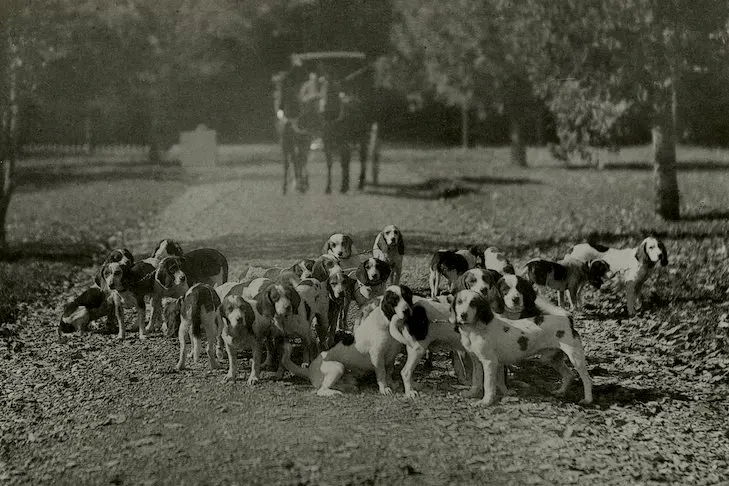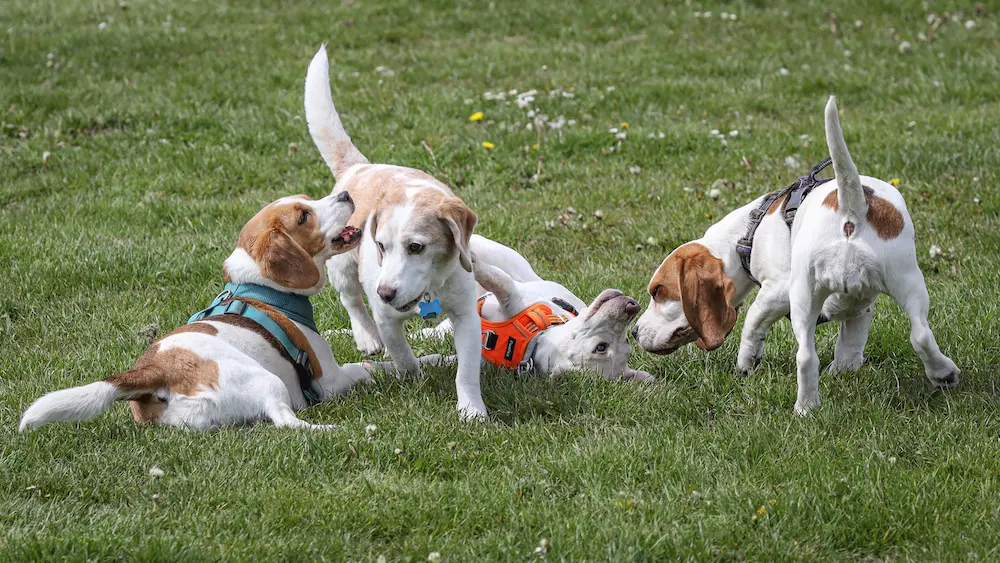Are Beagles the worst dogs? When it comes to canine companions, personal preference plays a substantial role. However, labeling any breed as “the worst dog” like some have done for Beagles, is overly simplistic and does not tell the whole story.
But first, let us explore their history.

The history of the Beagle dog breed can be traced back to Ancient Greece, where dogs of similar size and purpose were used for hunting around the 5th century. By the 8th century, a scent hound breed known as the St. Hubert Hound emerged, which could be an ancestor of the modern Beagle.
The Beagles, as we know them today, likely developed in England during the 1300s, and were used primarily for hunting game due to their incredible sense of smell. The breed gained popularity among British royalty, with King Edward II, Queen Elizabeth I, and King James I all showcasing their affection for Beagles.
In the 1800s, Beagles were imported to America, where breeders continued to develop the breed by refining their size, temperament, and hunting abilities.
Characteristics of Beagles
- Size: Beagles are medium-sized dogs, standing about 13 to 16 inches tall. They have a compact, solid build, weighing between 18 to 30 pounds (depending on the individual and diet).
- Appearance: Beagles have a distinct look with strong muzzles, dark brown or hazel eyes, and large, floppy ears. Their short, durable coat comes in many variations but typically includes white, fawn, and black patches.
- Behavior: Beagles are friendly, curious, and great with families. They often get along well with other dogs and can be highly social animals.
Why Some May Consider Beagles as the “Worst Dogs”

Labelling Beagles as the “worst dogs” is an unfair generalization. However, some challenges associated with Beagles might have led to such claims. Let’s explore the reasons why:
1. Stubbornness
Beagles have a reputation for being stubborn. This trait stems from their use as hunting dogs, where independence and determination were essential. As a result, they may find it harder to follow specific commands or rules set by their owners. The stubbornness can become a problem when it comes to training. Although intelligent, Beagles can be slow to pick up on obedience training due to their independent nature.
2. Vocalization
Beagles are often quite vocal, known for their distinctive howling, baying, and barking. Some potential reasons for their vocalization include:
- Boredom: When left alone for long periods or not adequately mentally stimulated, Beagles may become bored and vocalize their discontent.
- Separation anxiety: Beagles are social animals and may develop separation anxiety if left alone, leading to excessive barking or howling.
- Hunting instinct: Beagles were bred to be vocal while hunting, and this trait sometimes carries over into their behavior as pets.
Loud noises may be problematic for some people and their neighbors, adding to the perception of Beagles as being bad dogs.
3. High Energy Level
Beagles are energetic and require ample physical and mental stimulation to stay happy. If not catered to, their energy may become disruptive for the owners:
- Destructive behavior: Beagles may turn to chewing, digging, or other destructive behaviors if not given a proper outlet for their energy.
4. Prey Drive
Beagles have a strong prey drive and a keen sense of smell. While this trait is useful for hunting, it could become a challenge in day-to-day life such as:
- Wandering off: Since Beagles are scent-driven, they might get distracted by an interesting smell and wander off, even if it puts them in dangerous situations.
- Not being off-leash reliable: Beagles’ high prey drive means they are not always reliable when off-leash, as they might take off and become unresponsive to recall commands.
We need to understand that these challenges are not exclusive to Beagles and can be observed in other dog breeds as well. Instead of considering Beagles the worst dogs, it’s better to acknowledge the behavioral and training challenges associated with the breed and cater to their specific needs with training, socialization, and proper mental and physical stimulation.
How to Successfully Raise a Beagle

Raising a Beagle may come with its own set of challenges, but with the right strategies and an understanding of their needs, beagles can make exceptional pets. Let’s explore how to raise a Beagle successfully:
1. Obedience Training
Since Beagles are notoriously stubborn, a trait that stems from their history as independent hunters, it can result in them seeming challenging to train. Here are some tips for effective training:
- Start early: Start training your Beagle as soon as you bring them home. This way, they will become familiar with the rules and routines right from the beginning.
- Use positive reinforcement: Beagles respond well to rewards. Every time your Beagle behaves appropriately, reward them with treats, praises, or a favorite toy.
- Use a clicker: Clickers can be a great aid for training Beagles. A clicker helps capture the exact instant your Beagle performs the desired behavior.
- Be consistent and patient: Be consistent with your commands and training routines. Patience is vital as Beagles can be slow to pick up on your cues.
2. Physical Stimulation
Beagles have high energy levels, and they require plenty of exercises. Lack of physical activity can lead to overweight and destructive behavior.
- Regular Walks: Walking your Beagle on a regular schedule not only helps them use up energy but also gives them the opportunity to socialize with both humans and other pets.
- Play games: High-energy games like fetch or tug-of-war can be perfect physical stimulation for Beagles.
3. Mental Stimulation
Beagles are intelligent dogs with a strong sense of smell. Incorporating mental challenges into their daily routine can help keep their minds sharp.
- Scavenger hunts: Hide their toys or treats around the house or yard and encourage your Beagle to find them.
- Interactive toys: Use puzzle toys designed for dogs, which require your Beagle to solve puzzles to get the reward (usually food or treats).
- Training sessions: Training sessions not only teach obedience but also provide mental stimulation.
4. Socialization
Socialization is a key aspect of raising a well-behaved Beagle. Being naturally sociable dogs, Beagles need plenty of interaction with other dogs and people.
- Meet other dogs: Regularly visit dog parks or organize playdates with friends or neighbors who have dogs.
- Introduce to various environments: Exposing your Beagle to different environments, such as city streets, parks, and busy areas, will help them become comfortable in various settings.
Frequently Asked Questions
How big do Beagles get when fully grown?
Beagles are medium-sized dogs, standing about 13 to 16 inches tall and weighing between 18 to 30 pounds, depending on the individual and diet.
Are Beagles good family pets?
Yes, Beagles are friendly, curious, and great with families. They often get along well with other dogs, children, and adults, making them a popular choice for family pets.
How much exercise do Beagles need?
Beagles are energetic dogs that require regular physical activity. Aim for at least one hour of exercise per day, including walks, playtime, and mental stimulation in the form of scent games or puzzle toys.
What health issues are Beagles prone to?
Some common health issues in Beagles include hip dysplasia, epilepsy, hypothyroidism, ear infections, and cherry eye. Regular vet check-ups can help prevent and manage these health concerns.
Do Beagles shed a lot?
Beagles have a short coat with moderate shedding. Regular brushing can help reduce shedding and keep your Beagle’s coat clean and healthy.
Are Beagles good with other dogs?
Beagles generally get along well with other dogs. However, proper socialization from an early age with various dog breeds and sizes is essential for ensuring positive interactions.
Are Beagles hypoallergenic?
No, Beagles are not hypoallergenic. They shed moderately and produce dander, which can trigger allergies in sensitive individuals.
How long do Beagles live?
Beagles have an average life expectancy of 10-15 years. With proper care, regular vet check-ups, and a healthy diet, Beagles can lead long, happy lives.
How much do Beagles eat?
The amount of food a Beagle needs depends on their age, size, and activity level. Adult Beagles typically require 1 to 1.5 cups of high-quality dog food divided into two meals per day. Consult your veterinarian for specific dietary recommendations for your Beagle.
What is the best way to train a Beagle?
The key to training a Beagle is patience, consistency, and positive reinforcement. Start training early, use clicker training or reward-based methods, and be persistent with your commands.
Raising a Beagle requires understanding their requirements, having patience, and being consistent. Once you’ve provided the necessary training and care, you’ll have not just a pet but a lifelong loyal and loving companion.
